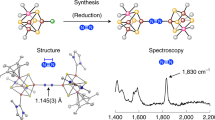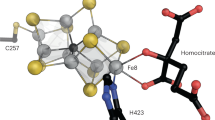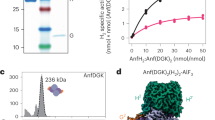Abstract
Nitrogenases are the enzymes by which certain microorganisms convert atmospheric dinitrogen (N2) to ammonia, thereby providing essential nitrogen atoms for higher organisms. The most common nitrogenases reduce atmospheric N2 at the FeMo cofactor, a sulfur-rich iron–molybdenum cluster (FeMoco)1,2,3,4,5. The central iron sites that are coordinated to sulfur and carbon atoms in FeMoco have been proposed to be the substrate binding sites, on the basis of kinetic and spectroscopic studies5,6,7. In the resting state, the central iron sites each have bonds to three sulfur atoms and one carbon atom. Addition of electrons to the resting state causes the FeMoco to react with N2, but the geometry and bonding environment of N2-bound species remain unknown5. Here we describe a synthetic complex with a sulfur-rich coordination sphere that, upon reduction, breaks an Fe–S bond and binds N2. The product is the first synthetic Fe–N2 complex in which iron has bonds to sulfur and carbon atoms, providing a model for N2 coordination in the FeMoco. Our results demonstrate that breaking an Fe–S bond is a chemically reasonable route to N2 binding in the FeMoco, and show structural and spectroscopic details for weakened N2 on a sulfur-rich iron site.
This is a preview of subscription content, access via your institution
Access options
Subscribe to this journal
Receive 51 print issues and online access
$199.00 per year
only $3.90 per issue
Buy this article
- Purchase on Springer Link
- Instant access to full article PDF
Prices may be subject to local taxes which are calculated during checkout



Similar content being viewed by others
References
Einsle, O. et al. Nitrogenase MoFe-protein at 1.16 Å resolution: a central ligand in the FeMo-cofactor. Science 297, 1696–1700 (2002)
Spatzal, T. et al. Evidence for interstitial carbon in nitrogenase FeMo cofactor. Science 334, 940 (2011)
Lancaster, K. M. et al. X-ray emission spectroscopy evidences a central carbon in the nitrogenase iron-molybdenum cofactor. Science 334, 974–977 (2011)
Wiig, J. A., Hu, Y., Lee, C. C. & Ribbe, M. W. Radical SAM-dependent carbon insertion into the nitrogenase M-cluster. Science 337, 1672–1675 (2012)
Hoffman, B. M., Lukoyanov, D., Yang, Z.-Y., Dean, D. R. & Seefeldt, L. C. Mechanism of nitrogen fixation by nitrogenase: the next stage. Chem. Rev. 114, 4041–4062 (2014)
Seefeldt, L. C., Hoffman, B. M. & Dean, D. R. Mechanism of Mo-dependent nitrogenase. Annu. Rev. Biochem. 78, 701–722 (2009)
Spatzal, T., Perez, K. A., Einsle, O., Howard, J. B. & Rees, D. C. Ligand binding to the FeMo-cofactor: structures of CO-bound and reactivated nitrogenase. Science 345, 1620–1623 (2014)
Yandulov, D. V. & Schrock, R. R. Catalytic reduction of dinitrogen to ammonia at a single molybdenum center. Science 301, 76–78 (2003)
Holland, P. L. Low-coordinate iron complexes as synthetic models of nitrogenase. Can. J. Chem. 83, 296–301 (2005)
MacBeth, C. E., Harkins, S. B. & Peters, J. C. Synthesis and characterization of cationic iron complexes supported by the neutral ligands NPi-Pr3, NArPi-Pr3, and NSt-Bu3 . Can. J. Chem. 83, 332–340 (2005)
Dance, I. Ramifications of C-centering rather than N-centering of the active site FeMo-co of the enzyme nitrogenase. Dalton Trans. 41, 4859–4865 (2012)
Hinnemann, B. & Nørskov, J. K. Chemical activity of the nitrogenase FeMo cofactor with a central nitrogen ligand: density functional study. J. Am. Chem. Soc. 126, 3920–3927 (2004)
George, S. J. et al. EXAFS and NRVS reveal a conformational distortion of the FeMo-cofactor in the MoFe nitrogenase propargyl alcohol complex. J. Inorg. Biochem. 112, 85–92 (2012)
Creutz, S. E. & Peters, J. C. Catalytic reduction of N2 to NH3 by an Fe–N2 complex featuring a C-atom anchor. J. Am. Chem. Soc. 136, 1105–1115 (2014)
Anderson, J. S., Rittle, J. & Peters, J. C. Catalytic conversion of nitrogen to ammonia by an iron model complex. Nature 501, 84–87 (2013)
Kästner, J. & Blöchl, P. E. Ammonia production at the FeMo cofactor of nitrogenase: results from density functional theory. J. Am. Chem. Soc. 129, 2998–3006 (2007)
Schimpl, J., Petrilli, H. M. & Blöchl, P. E. Nitrogen binding to the FeMo-cofactor of nitrogenase. J. Am. Chem. Soc. 125, 15772–15778 (2003)
Alwaaly, A., Dance, I. & Henderson, R. A. Unexpected explanation for the enigmatic acid-catalysed reactivity of [Fe4S4X4]2− clusters. Chem. Commun. 50, 4799–4802 (2014)
Saouma, C. T., Morris, W. D., Darcy, J. W. & Mayer, J. M. Protonation and proton-coupled electron transfer at S-ligated [4Fe-4S] clusters. Chem. Eur. J. 21, 9256–9260 (2015)
Lee, S. C., Lo, W. & Holm, R. H. Developments in the biomimetic chemistry of cubane-type and higher nuclearity iron–sulfur clusters. Chem. Rev. 114, 3579–3600 (2014)
Ung, G. & Peters, J. C. Low-temperature N2 binding to two-coordinate L2Fe0 enables reductive trapping of L2FeN2− and NH3 generation. Angew. Chem. Int. Ed. 54, 532–535 (2015)
Rodriguez, M. M., Bill, E., Brennessel, W. W. & Holland, P. L. N2 reduction and hydrogenation to ammonia by a molecular iron-potassium complex. Science 334, 780–783 (2011)
Hazari, N. Homogeneous iron complexes for the conversion of dinitrogen into ammonia and hydrazine. Chem. Soc. Rev. 39, 4044–4056 (2010)
Danopoulos, A. A., Wright, J. A. & Motherwell, W. B. Molecular N2 complexes of iron stabilised by N-heterocyclic ‘pincer’ dicarbene ligands. Chem. Commun. 784–786 (2005)
Takaoka, A., Mankad, N. P. & Peters, J. C. Dinitrogen complexes of sulfur-ligated iron. J. Am. Chem. Soc. 133, 8440–8443 (2011)
Bart, S. C., Lobkovsky, E., Bill, E., Wieghardt, K. & Chirik, P. J. Neutral-ligand complexes of bis(imino)pyridine iron: synthesis, structure, and spectroscopy. Inorg. Chem. 46, 7055–7063 (2007)
Creutz, S. E. & Peters, J. C. Diiron bridged-thiolate complexes that bind N2 at the FeIIFeII, FeIIFeI, and FeIFeI redox states. J. Am. Chem. Soc. 137, 7310–7313 (2015)
Ellison, J. J., Ruhlandt-Senge, K. & Power, P. P. Synthesis and characterization of thiolato complexes with two-coordinate iron(II). Angew. Chem. Int. Edn Engl. 33, 1178–1180 (1994)
Suess, D. L. M. & Peters, J. C. H–H and Si–H bond addition to Fe≡NNR2 intermediates derived from N2 . J. Am. Chem. Soc. 135, 4938–4941 (2013)
Moret, M.-E. & Peters, J. C. Terminal iron dinitrogen and iron imide complexes supported by a tris(phosphino)borane ligand. Angew. Chem. Int. Ed. 50, 2063–2067 (2011)
Acknowledgements
This work was supported by the National Institutes of Health (GM065313 to P.L.H.) and the Max Planck Society (E.B.). We thank A. Göbels for measurement of SQUID data and G. Brudvig for the use of an EPR spectrometer. Elemental analysis data were from the CENTC Elemental Analysis Facility at the University of Rochester, funded by the NSF (CHE-0650456), and we thank W. Brennessel for collecting these data. This work was supported in part by the facilities and staff of the Yale High Performance Computing Center, which was partially funded by the NSF (CNS 08-21132). We thank J. Mayer, N. Hazari, S. Bonyhady, N. Arnet, and C. MacLeod for constructive criticism on the manuscript.
Author information
Authors and Affiliations
Contributions
I.Č. designed the iron–sulfur–carbon system for N2 binding, performed the laboratory experiments, and analysed data. B.Q.M. collected and interpreted crystallographic data. E.B. interpreted solid-state (SQUID) magnetic data. D.J.V. collected and fitted EPR data. P.L.H. supervised the research, and I.Č. and P.L.H. wrote the manuscript.
Corresponding author
Ethics declarations
Competing interests
The authors declare no competing financial interests.
Additional information
X-ray crystallographic data have been deposited in the Cambridge Crystallographic Data Centre (http://www.ccdc.cam.ac.uk/) with deposition numbers CCDC1402555–CCDC1402559.
Supplementary information
Supplementary Information
This file contains Supplementary Methods, Supplementary References and Supplementary Data (see Contents for details). (PDF 10994 kb)
Rights and permissions
About this article
Cite this article
Čorić, I., Mercado, B., Bill, E. et al. Binding of dinitrogen to an iron–sulfur–carbon site. Nature 526, 96–99 (2015). https://doi.org/10.1038/nature15246
Received:
Accepted:
Published:
Issue Date:
DOI: https://doi.org/10.1038/nature15246
This article is cited by
-
Direct Z-scheme photocatalytic nitrogen reduction to ammonia with water in metal-free BC4N/aza-CMP heterobilayer
Science China Materials (2023)
-
Polyoxometalates-derived ternary metal oxides electrocatalyst for N2 reduction under ambient conditions
Tungsten (2023)
-
Nitrogen reduction by the Fe sites of synthetic [Mo3S4Fe] cubes
Nature (2022)
-
Synthetic molecular cluster hints at mechanism of nitrogen fixation
Nature (2022)
-
Synthesis of atomic platinum with high loading on metal-organic sulfide
Science China Materials (2022)
Comments
By submitting a comment you agree to abide by our Terms and Community Guidelines. If you find something abusive or that does not comply with our terms or guidelines please flag it as inappropriate.



